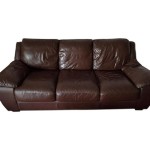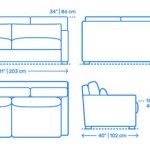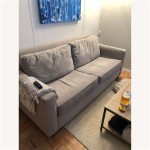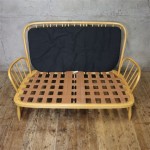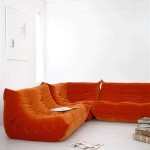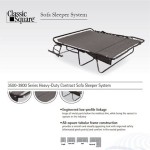Deciphering the Dimensions: Understanding 2-Person Sofa Sizes
Choosing the right sofa is a crucial decision in furnishing any living space. Among the myriad options, the two-person sofa, often referred to as a loveseat, presents a versatile solution for smaller apartments, cozy living rooms, or even as a complementary piece in larger spaces. However, the term "2-person sofa" can be misleading without precise size specifications. This article delves into the typical dimensions of a two-person sofa, exploring the variations and factors that influence its overall size.
The term "2-person sofa" doesn't represent a universally standardized size. Instead, it describes a sofa designed to comfortably accommodate two adults. The actual dimensions can vary significantly between manufacturers and even within the same brand, depending on the specific design and style. Understanding these variations is key to selecting a sofa that fits both the available space and the intended purpose.
Generally, a two-person sofa ranges in width from approximately 58 inches to 72 inches (147 cm to 183 cm). The depth, or distance from the front of the sofa to the back, typically falls between 30 inches and 40 inches (76 cm to 102 cm). The height, measured from the floor to the top of the backrest, can vary from 30 inches to 36 inches (76 cm to 91 cm) or even higher, depending on the style and whether the sofa features a high back or decorative elements.
These measurements are considered the overall or external dimensions. The internal or seating dimensions, which are crucial for determining actual comfort, are typically smaller. The seat width, the space actually available for sitting, might be several inches less than the sofa's overall width, accounting for armrests and side cushioning. Similarly, the seat depth, the distance from the front of the seat cushion to the back cushion, impacts how comfortably a person can sit or recline.
Furthermore, armrest styles play a crucial role in the overall width and usable seating space. Sofas with thick, rolled armrests will have a greater overall width but potentially less seating space compared to sofas with narrow, track armrests. Considerations for seat height, measured from the floor to the top of the seat cushion, are also important for comfort, particularly for individuals with mobility concerns.
Factors such as the sofa's design style (e.g., modern, traditional, mid-century) and the materials used in its construction also influence the overall size. For instance, a traditional sofa with rolled arms and a high back will likely be larger than a sleek, modern sofa with minimalist lines. Similarly, a sofa with thick padding and generously sized cushions will occupy more space than a sofa with thinner cushions.
Before purchasing a two-person sofa, it is imperative to accurately measure the available space, considering not just the length and width, but also the height and any potential obstructions such as doorways, windows, or radiators. A floor plan, even a simple sketch, can be invaluable in visualizing how the sofa will fit within the room and ensuring sufficient space for movement around it.
Key Point 1: Understanding Typical Dimensions
The typical dimensions of a two-person sofa, while not standardized, provide a useful guideline for initial planning. The width generally ranges from 58 to 72 inches, the depth falls between 30 and 40 inches, and the height varies from 30 to 36 inches or more. These measurements represent the overall size, and the internal seating dimensions will typically be smaller. Accurate measurement of the available space is crucial for ensuring the sofa fits comfortably within the room.
These general dimensions are subject to variation based on several factors, including design style, armrest style, and cushion thickness. Modern sofas tend to have a smaller overall footprint compared to traditional sofas. Armrest styles, whether rolled, track, or armless, can significantly affect the overall width of the sofa and the usable seating space. Cushions that are thick or generously padded will contribute to a larger overall size.
When considering a two-person sofa, it's also important to consider the clearance space surrounding the sofa. This includes leaving sufficient room for walkways, other furniture, and access to doorways. A cramped space can make a room feel smaller and less inviting, even if the sofa itself fits within the dimensions.
The perspective from which the dimensions are viewed is also important. When considering dimensions, it's helpful to visualize the sofa in three dimensions – width, depth, and height. This can help to avoid purchasing a sofa that is too tall, too deep, or too wide for the space.
Understanding the typical dimensions doesn't absolve the need for precise measurements of both the available space and the specific sofa models being considered. Reputable retailers provide detailed product specifications, including dimensions, materials, and construction details. Consulting these specifications and, if possible, physically inspecting the sofa before purchase is highly advisable.
Key Point 2: The Impact of Sofa Style and Design
The aesthetic design and overall style of a two-person sofa profoundly influence its dimensions and suitability for a particular space. Modern, minimalist sofas often prioritize clean lines and compact profiles, resulting in smaller overall dimensions compared to traditional, ornate sofas. Traditional sofas, with their rolled arms, tufted backs, and generous cushioning, tend to be larger and occupy more space. Mid-century modern sofas often strike a balance, featuring streamlined designs with slightly angled legs and comfortable seating.
The design of the armrests significantly affects the overall width and useful seating space. Rolled armrests, while aesthetically pleasing, consume more width than track armrests, which are typically flat and streamlined. Armless sofas, which lack armrests entirely, maximize seating space within a given width. The height of the armrests also contributes to the overall aesthetic and comfort, with higher armrests providing more support but potentially making the sofa appear bulkier.
The back height also varies significantly across different sofa styles. Sofas with high backs offer greater back support and create a more formal aesthetic, but they can also visually dominate a room. Low-back sofas, on the other hand, create a more open and airy feel, making them well-suited for smaller spaces. The backrest design, whether tufted, buttoned, or plain, also contributes to the overall aesthetic and visual weight of the sofa.
Leg style also influences the apparent size and overall aesthetic of a two-person sofa. Exposed legs, particularly those made of wood or metal, can create a sense of lightness and airiness, making the sofa appear less bulky. Conversely, sofas with skirted bottoms, where the fabric extends to the floor, have a more solid and grounded appearance. The height of the legs also affects the seating height, which is an important consideration for comfort and accessibility.
The choice of fabric and upholstery also plays a role in the perceived size and style of the sofa. Light-colored fabrics tend to make the sofa appear larger, while darker fabrics create a more compact and intimate feel. Textured fabrics add visual interest and depth, while smooth fabrics create a more minimalist and streamlined look. The durability and maintenance requirements of the chosen fabric are also important considerations for long-term satisfaction.
Key Point 3: Measuring Space and Considering Clearance
Accurate measurement of the intended space is paramount before purchasing a two-person sofa. Simply estimating the available space can lead to costly mistakes and dissatisfaction. A thorough measurement should include the length, width, and height of the area, as well as any potential obstructions or architectural features that might affect the placement of the sofa.
Before measuring, clear the area of any existing furniture or clutter to obtain an accurate representation of the available space. Use a measuring tape, preferably one that is at least 10 feet long, to measure the dimensions of the room. Record the measurements carefully, paying attention to units (inches or centimeters) and ensuring consistency throughout the process.
Consider the placement of doorways, windows, radiators, and electrical outlets when planning the sofa's location. Ensure that the sofa does not obstruct doorways or windows, and that it allows for easy access to outlets for lamps and other electrical devices. Radiators can generate significant heat, so it's important to position the sofa at a safe distance to prevent damage to the upholstery or cushions.
Account for clearance space around the sofa to ensure comfortable movement and access to other furniture. A minimum of 18 inches of clearance is generally recommended for walkways, allowing people to move freely without squeezing past the sofa. Allow sufficient space for opening and closing doors and drawers, and for accessing other seating areas or tables.
When measuring for a two-person sofa, consider the depth of the sofa as well as its width. The depth determines how far the sofa will extend into the room, and it's important to ensure that it doesn't block walkways or make the room feel cramped. Measure the depth from the front of the sofa to the back, and factor this measurement into the overall space planning.
Finally, consider the height of the sofa in relation to other furniture and architectural features. A sofa that is too tall can visually dominate a room and block views, while a sofa that is too low can feel uncomfortable and out of proportion. Measure the height from the floor to the top of the backrest, and compare this measurement to the height of other furniture and architectural elements in the room.
By carefully measuring the available space and considering the factors that influence the overall size of a two-person sofa, it is possible to select a piece that not only fits comfortably within the room but also complements the overall aesthetic and enhances the functionality of the space.

Byron Grey Fabric 2 Seater Sofa Furniturein

Buy Float Two Seater Sofa Set By Spns Furniture
Vimle Sleeper Sofa 2 Seater Dimensions Drawings Com

Luna 2 Seater Sofa With Ottoman Water Repellent Fabric Bedandbasics

G Plan Vintage The Sixty Eight Lhf Small 2 Seater Sofa With Single Footrest Mechanism Marl Green

Paddington Textured Fabric 2 Seater Sofa Affordable Luxury Furniture Lux Street

Buy Flora Beige And Dark Brown Colour Two Seater Sofa At Best

Hepburn Shabby Chic Vintage Leather Small 2 Seater Sofa

Parker Knoll Devonshire Large 2 Seater Sofa Aldiss

Nill Astonic 2 Seater Fabric Sofa Beige Furniture

